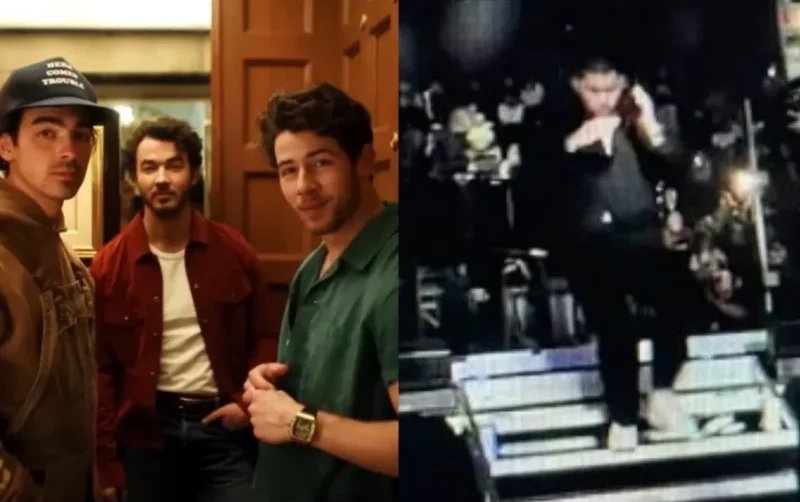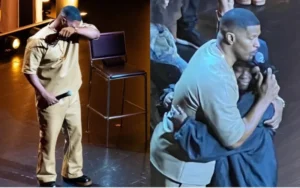Introduction to the Incident
During a recent concert that left fans in shock, Nick Jonas experienced a startling incident involving a laser. The event took place in an arena filled to capacity, with thousands of enthusiastic fans eagerly awaiting his performance. The atmosphere was electric, characterized by a palpable sense of excitement as the audience engaged with his music and interacted with the on-stage visual effects that enhanced the concert experience.
As the show progressed, lights danced and lasers twirled, enveloping the stage in a mesmerizing spectacle. However, the excitement took a sudden turn when an unexpected incident involving a misdirected laser light occurred. Initially, the audience reacted with confusion, as many were unaware of the potential danger posed by the equipment. The incident unfolded rapidly, creating an atmosphere of uncertainty as concertgoers processed what was happening.
This alarming moment served as a stark reminder of the inherent risks associated with live performances. While many concerts employ advanced technologies to create immersive experiences, safety must always remain a priority. The implications for performers and fans are significant, emphasizing the need for rigorous safety protocols when utilizing laser effects. This incident raises essential questions not only about the technical aspects of concert production but also about the responsibilities shared by artists, event organizers, and venues to ensure a secure environment.
Incidents like this highlight the importance of vigilance in the realm of live entertainment. As fans continue to flock to concerts in search of memorable experiences, it is crucial that all parties involved take proactive measures to guarantee the safety of both performers and attendees alike.
Details of the Laser Scare
During a recent concert, an alarming incident involving a laser occurred, prompting a swift response from Nick Jonas and his team. The laser in question was classified as a high-powered green laser, known for its intensity and visibility. This particular type of laser is often used in live performances for visual effects; however, it can pose serious risks if not handled with caution. The moment the laser beam illuminated the stage, it was perceived as both intriguing and unsettling. From eye-witness accounts, it became evident that the initial reaction from the audience was one of awe, but that soon turned to confusion as the beam unexpectedly targeted Jonas himself.
An immediate sense of chaos ensued as audience members were left unsure of the origin and intentions behind the laser. Nick Jonas, feeling the uncomfortable heat of the high-powered beam, decided to leave the stage, prioritizing his safety. Eyewitnesses reported gasps of disbelief from the crowd, followed by a wave of alarmed reactions among fans who were present. Social media lit up moments later, with attendees sharing their experiences and expressing concern over the incident. Many fans conveyed mixed feelings—some were appreciative of Jonas’s quick departure for safety’s sake, while others were anxious about the potential risks that such incidents may pose during live performances.
The incident also sparked conversation about the use of lasers in concerts. While they can enhance the visual appeal of performances, previous warnings from safety regulators highlight the need for stricter control in their use. The potential for harm, particularly to performers and audience members alike, cannot be understated. This particular event serves as a reminder of the delicate balance between entertainment and safety, urging the industry to reassess its protocols concerning laser use during live shows.
Nick Jonas’s Response and Fan Reactions
Following the alarming laser incident during his concert, Nick Jonas and his team swiftly addressed the situation to reassure both the audience and his followers. In a statement released shortly after the concert, Jonas expressed his gratitude for the fans’ understanding and support. He emphasized that the safety of his audience and crew is his top priority, acknowledging the shock and confusion many felt during the performance. The incident prompted Jonas to reflect on the importance of safety measures and protocols at live shows to prevent similar occurrences in the future.
Fans responded overwhelmingly on social media, showcasing a blend of concern and support for the artist. Many took to platforms such as Twitter and Instagram to voice their worry for Jonas’s wellbeing after he left the stage abruptly. The hashtag ‘#GetWellNick’ began to trend, with numerous fans sharing their thoughts and sending positive messages. Some expressed their immediate discomfort during the incident and shared their relief upon realizing that Jonas was unharmed. The outpouring of fan support highlighted the emotional connection that many feel with Jonas, pointing to the strong bond that exists between artists and their audiences.
Additionally, discussions around safety and mental well-being at live performances emerged online. Concert-goers reflected on how such incidents can affect not only the performers but also the fans present. Many called for increased safety measures at events, urging venues to implement more comprehensive protocols. As the dust settled from the scare, it became clear that artists like Jonas address their emotional and physical safety during performances, a topic that deserves attention in today’s music industry landscape.
Safety Protocols in Concerts and Performances
In recent years, the safety of concertgoers and performers has become a focal point of discussion within the music industry. Incidents like the alarming laser scare experienced by Nick Jonas serve as a wake-up call, highlighting the necessity for comprehensive safety protocols at live performances. Concert organizers, venue managers, and performers must work collaboratively to ensure that appropriate measures are in place to prevent such occurrences.
Industry standards often include detailed risk assessments before events, where potential hazards are identified and addressed. Best practices involve clear communication of safety protocols to staff, performers, and audiences. For example, comprehensive training for stage crew members on the proper handling of equipment, particularly lasers and pyrotechnics, can greatly reduce risks associated with their use. Additionally, establishing clear guidelines regarding audience behavior can help mitigate dangerous situations that may arise during performances.
Experts in concert safety advocate for the implementation of advanced technology to monitor and control potentially harmful elements during shows. This includes the use of automated systems that can detect unsafe conditions in real-time, alerting staff to take necessary actions. Moreover, industry professionals emphasize the importance of post-event evaluations. These assessments allow organizers to analyze incidents critically, ensuring continuous improvement in safety practices for future events.
Furthermore, the music industry appears to be evolving its approach to balancing thrilling live performances with the imperative for safety. Venue designs are progressively incorporating features that prioritize crowd control and emergency exits. As audience expectations for exciting and immersive experiences grow, it is crucial for the industry to adapt, ensuring that safety remains a top priority without sacrificing the enjoyment that live music delivers.
In conclusion, the incident involving Nick Jonas underscores the urgent need for stringent safety protocols in the concert and performance industry. By prioritizing comprehensive safety measures, the music industry can work towards an environment where both performers and audiences feel secure, allowing the magic of live performances to continue uninterrupted.




